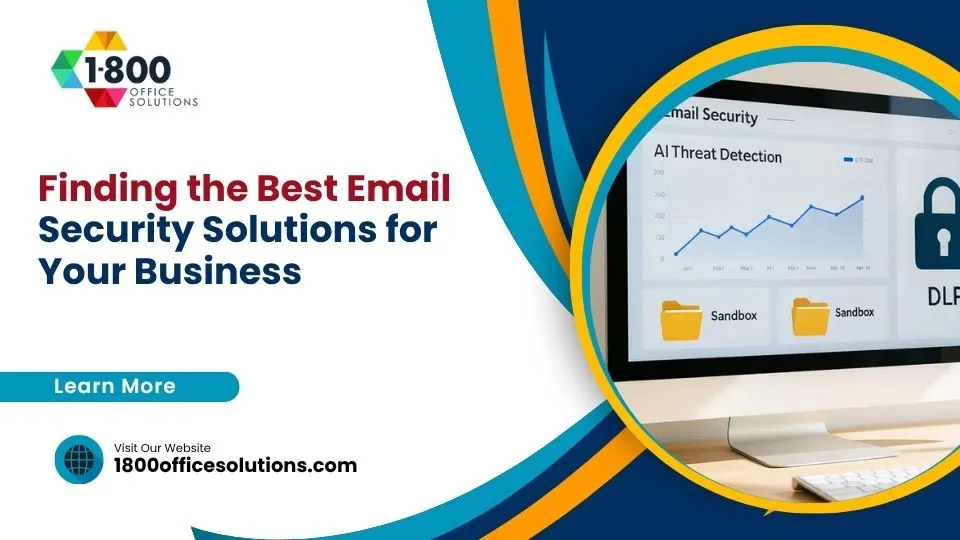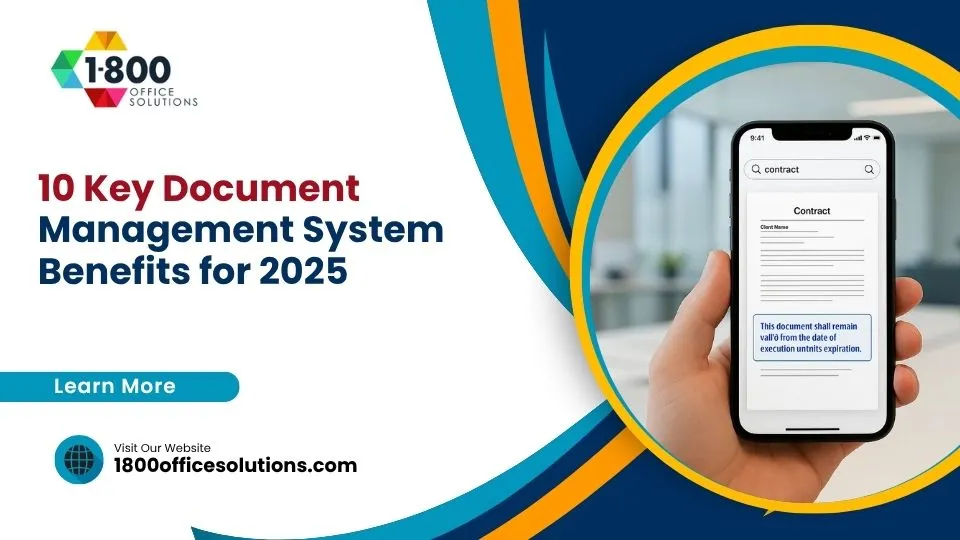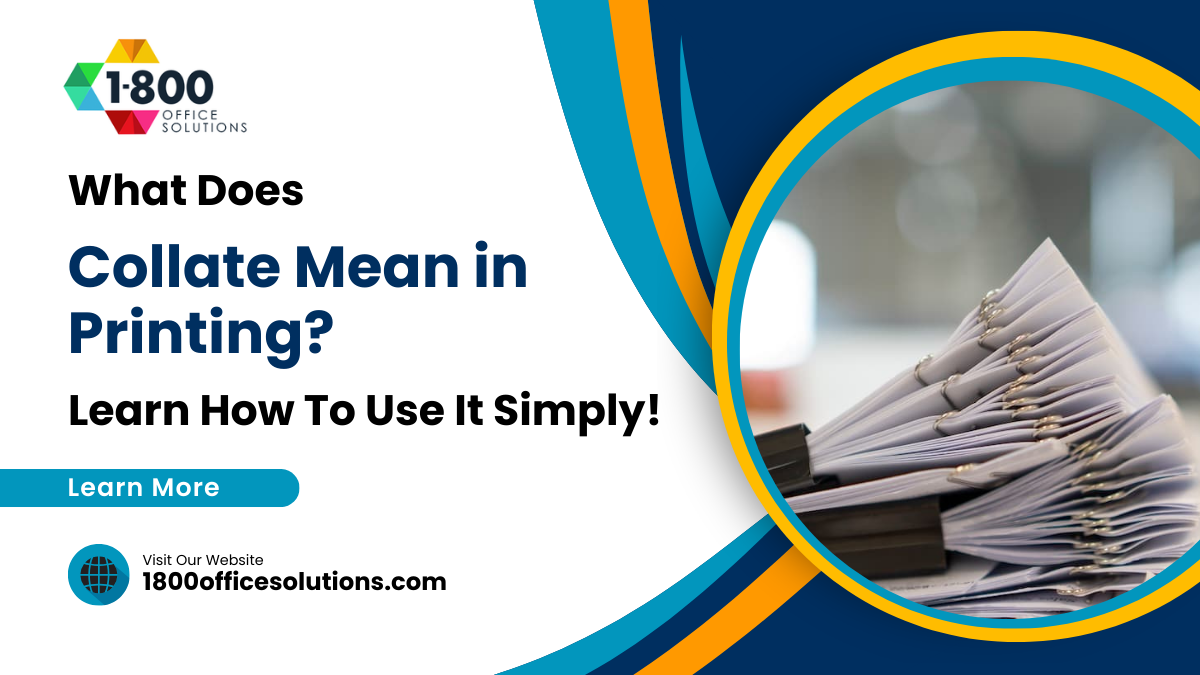10 Essential Document Management Best Practices for 2025
AI Overview:
This blog breaks down 10 essential document management best practices to help businesses turn scattered files into a secure, organized, and efficient system. It covers core steps like creating a centralized repository, using clear classification and version control, setting strong access permissions, and managing documents through their full lifecycle. It also highlights the importance of metadata, search optimization, workflow automation, encryption, and disaster recovery planning. Together, these practices help businesses boost productivity, protect sensitive data, support compliance, and ensure information is always accessible when needed.
Managing the ever-growing volume of documents—from contracts and invoices to employee records and project plans—is more critical than ever. Simply storing files on scattered drives or in overflowing email inboxes creates inefficiency, introduces security risks, and can lead to serious compliance nightmares. A robust document management strategy is no longer a luxury for large corporations; it’s a foundational necessity for businesses of all sizes looking to streamline operations, protect sensitive data, and maintain a competitive edge.
This article rounds up 10 essential document management best practices that provide a comprehensive framework for transforming your information governance from a chaotic liability into a strategic asset. We will move beyond generic advice to offer actionable insights and practical examples you can implement immediately. You will learn how to build a system that not only organizes your files but also enhances productivity, strengthens security, and ensures you are prepared for audits and potential disasters. To gain a deeper understanding of the systems that underpin modern document management strategies, consider consulting this comprehensive Electronic Document Management Systems (EDMS) guide.
From establishing a centralized repository and enforcing version control to automating workflows and planning for business continuity, each practice covered here is a critical component of a successful document ecosystem. Whether you are an office manager at a growing SMB, an IT administrator in a multi-location enterprise, or part of an AEC team handling complex project files, these principles will help you regain control over your most valuable asset: your information. Let’s explore the proven methods that will make your documents work for you, not against you.
1. Establish a Centralized Document Repository
The foundation of any effective document management strategy is a centralized repository. This is a single, unified digital location where all organizational documents are stored, organized, and accessed. Moving away from scattered files on local drives, email inboxes, and various cloud services eliminates information silos and establishes a single source of truth. The primary goal is to transform the chaotic process of finding critical information into a streamlined, effortless task.
A central repository ensures that everyone works from the most current and approved versions of documents. This simple shift dramatically reduces errors, minimizes rework, and enhances team collaboration by providing consistent, reliable access to essential data. This practice is crucial for maintaining data integrity and operational efficiency across all departments.
Why This Is a Core Practice
Scattered documents create a state of digital anarchy. A central repository imposes order, making information accessible, secure, and manageable. This structured approach is a cornerstone of modern document management best practices because it directly impacts productivity, security, and compliance. Without a central hub, enforcing policies on access control, retention schedules, and versioning is nearly impossible.
How to Implement It
- Select the Right Platform: Choose a system that aligns with your organization’s needs. For example, Microsoft SharePoint is ideal for enterprise-level collaboration within the Microsoft 365 ecosystem. Google Workspace (Google Drive) offers a flexible, cloud-native solution perfect for agile SMBs. For organizations in highly regulated sectors like life sciences or government, a platform like OpenText Documentum provides robust compliance and control features.
- Plan Before You Migrate: Before moving a single file, meticulously define your folder structure and naming conventions. A logical hierarchy is key to long-term success.
- Leverage Metadata: Go beyond folders. Use metadata tags (e.g., “Client Name,” “Project ID,” “Status”) to enable powerful, multi-faceted searches that a rigid folder structure cannot support alone.
- Automate Maintenance: Implement automated workflows to archive old documents or flag files for review based on your retention policy. This prevents the repository from becoming a digital junkyard.
Key Takeaway: A centralized document repository isn’t just about storage; it’s about creating a single, authoritative ecosystem for your organization’s most valuable asset: its information. By unifying where documents live, you build the foundation for all other management and security protocols.
2. Implement Document Classification and Taxonomy
With a centralized repository in place, the next step is to create order within it. Document classification and taxonomy provide a systematic framework for categorizing, tagging, and organizing files. This involves creating a consistent classification scheme and a logical, hierarchical structure (taxonomy) that makes document retrieval intuitive and efficient. The goal is to move from a chaotic digital pile to a well-organized library where anyone can find what they need, when they need it.
A well-defined taxonomy ensures that documents are stored logically and consistently across the entire organization. This structured approach is fundamental for searchability, compliance, and applying security or retention policies. For example, a legal firm can organize case files by type (e.g., litigation, contract), client, and matter number, ensuring rapid access during critical proceedings.
Why This Is a Core Practice
Without a formal classification system, your central repository is just a larger, more organized mess. A robust taxonomy is a core component of document management best practices because it transforms data into findable, usable information. It underpins effective search, automates governance policies like retention and access control, and reduces the time employees waste looking for documents, directly boosting productivity.
How to Implement It
- Involve Stakeholders: Develop your taxonomy collaboratively. Involve representatives from different departments (e.g., Finance, HR, Legal) to ensure the structure meets everyone’s needs. A system designed in a vacuum is doomed to fail.
- Start Simple and Scale: Begin with a high-level, intuitive structure. A financial institution might start with categories like “Compliance,” “Client Accounts,” and “Internal Audits,” then build out sub-categories. An overly complex system discourages user adoption.
- Automate with Technology: Leverage your document management system’s capabilities for auto-tagging and classification. Many modern platforms use AI and machine learning to analyze document content and apply appropriate metadata automatically, reducing manual effort and human error.
- Document and Train: Create clear documentation explaining the classification system and provide training to all users. Consistency is key, and it can only be achieved if everyone understands and follows the same rules.
Key Takeaway: A document taxonomy is the intellectual blueprint for your digital filing system. It’s not just about creating folders; it’s about establishing a shared language for how your organization categorizes and values its information, making it accessible, secure, and compliant.
3. Version Control and Document Versioning
Effective version control is the systematic practice of managing and tracking changes to a document throughout its lifecycle. It prevents the confusion of having multiple, conflicting file versions (e.g., “Report_Final_v2_Johns-edits.docx”) by creating a clear, auditable history of every modification. This ensures that team members are always working from the most current, authoritative draft while retaining the ability to access or restore previous iterations.

This process is fundamental for collaborative projects, legal documents, and any file that undergoes review and revision. By maintaining a single master document with a detailed version history, organizations eliminate redundant work, prevent accidental overwrites, and maintain a clear record of who made what changes and when. This traceability is invaluable for audits, dispute resolution, and quality control.
Why This Is a Core Practice
Without systematic versioning, collaboration descends into chaos. Team members waste time reconciling conflicting edits and risk making critical decisions based on outdated information. Implementing robust version control is a cornerstone of document management best practices because it guarantees data integrity and enhances accountability. It provides a safety net, allowing users to revert to a stable previous version if an error is introduced, making the editing process more secure and less stressful.
How to Implement It
- Utilize Built-in System Features: Most modern document management systems have native versioning. For example, Google Docs automatically saves a comprehensive version history for every document, while Microsoft 365 offers similar capabilities in SharePoint and OneDrive, complete with check-in/check-out functions for exclusive editing.
- Establish Clear Naming Standards: Define a consistent versioning scheme, such as semantic versioning (e.g., v1.0 for major releases, v1.1 for minor updates). Supplement this with descriptive labels like “Draft,” “For Review,” and “Approved” to clearly communicate a document’s status.
- Train Users on Best Practices: Educate your team on when to save a new version versus making minor edits. A new version should be created for significant changes, while minor typographical fixes may not require it.
- Automate Archiving and Cleanup: Set retention policies within your DMS to automatically archive or delete old, unnecessary versions after a specified period. This keeps your system clean and storage costs manageable without losing critical historical data.
Key Takeaway: Version control transforms documents from static files into living records with a complete, traceable history. It is the mechanism that ensures clarity, prevents data loss, and empowers confident collaboration across your organization.
4. Access Control and Permissions Management
Effective document management is not just about organization; it’s fundamentally about control. Access control and permissions management is the practice of defining and enforcing who can view, edit, share, or delete documents. This is based on user roles, responsibilities, and the principle of least privilege, ensuring that sensitive information remains secure and document integrity is maintained at all times.

This structured approach transforms your document repository from a free-for-all library into a secure vault. It prevents unauthorized access, accidental deletions, and unapproved changes, which are critical for protecting intellectual property, customer data, and financial records. For any organization, especially those in regulated industries, robust permissions management is non-negotiable.
Why This Is a Core Practice
Without granular access controls, your most sensitive data is exposed to significant risk from both internal and external threats. Implementing a formal permissions strategy is a cornerstone of modern document management best practices because it directly supports security, compliance, and operational discipline. It ensures that employees only have access to the information they absolutely need to perform their jobs, minimizing the attack surface and potential for data breaches. This is essential for meeting compliance standards like GDPR, HIPAA, and Sarbanes-Oxley.
How to Implement It
- Implement Role-Based Access Control (RBAC): Instead of assigning permissions to individual users, create roles (e.g., “HR Manager,” “Sales Associate,” “Project Lead”). Assign permissions to these roles, then assign users to the appropriate roles. This simplifies administration and ensures consistency.
- Adopt the Principle of Least Privilege: This is the golden rule of access control. Grant users the absolute minimum level of access required for their job functions. A user who only needs to read reports should not have editing or deletion rights.
- Conduct Regular Permission Audits: Schedule quarterly or bi-annual audits of all user permissions. This helps identify and remove instances of “privilege creep,” where users accumulate unnecessary access over time.
- Establish a Formal Access Request/Revocation Process: Document the procedure for granting and revoking access. All requests should require justification and manager approval. When an employee leaves the company, their access must be immediately revoked as part of the offboarding process.
Key Takeaway: Access control is the gatekeeper of your digital information. By systematically managing who can do what with your documents, you build a powerful security layer that protects against human error and malicious intent, ensuring data integrity and compliance.
5. Implement Document Lifecycle Management (DLM)
Document Lifecycle Management (DLM) is a systematic approach to managing a document’s entire journey, from its creation to its final disposition. This framework ensures that information is handled appropriately at every stage: creation, review, distribution, active use, archival, and eventual destruction. The core purpose of DLM is to apply consistent, policy-driven rules that govern how long documents are kept, who can access them, and how they are ultimately disposed of, aligning business operations with legal and regulatory obligations.
By treating documents as assets with a finite lifespan, DLM prevents the uncontrolled accumulation of outdated or redundant data. This proactive management reduces storage costs, mitigates legal risk, and simplifies information retrieval by ensuring that only relevant, current, and necessary documents are kept active. It is a critical practice for organizations in regulated industries, such as finance or healthcare, where improper record handling can lead to severe penalties.
Why This Is a Core Practice
Without a defined lifecycle, a document repository can quickly become a digital landfill, filled with trivial, obsolete, and potentially risky information. A structured DLM process is one of the most vital document management best practices because it enforces compliance and enhances operational efficiency. It provides a defensible framework for destroying data, which is just as important as retaining it. This process is essential for meeting requirements like the Gramm-Leach-Bliley Act for banks or NARA standards for federal records.
How to Implement It
- Map Document Lifecycles: Begin by identifying key document types (e.g., contracts, invoices, employee records) and creating visual flowcharts that map out each stage of their life. For example, a contract might move from “Draft” to “In Review,” “Active,” “Expired,” and finally “Destroyed after 7 years.”
- Automate Lifecycle Transitions: Use your document management system to set up automated triggers. Configure rules that automatically move a document from an active folder to an archive after a project is closed or flag a record for destruction once its mandated retention period expires.
- Incorporate Legal Hold Capabilities: Ensure your system can implement a “legal hold.” This feature overrides standard retention policies, preventing the deletion of documents relevant to litigation or an investigation. This is a non-negotiable feature for risk management.
- Conduct Regular Audits: Schedule periodic audits to verify that lifecycle policies are being followed correctly. This review process helps identify gaps in your process, confirms compliance, and ensures the system is functioning as intended.
Key Takeaway: Document Lifecycle Management transforms information governance from a passive concept into an active, automated process. By methodically managing documents from creation to destruction, you minimize risk, control storage costs, and ensure your organization’s records are both compliant and a source of value, not liability.
6. Search and Retrieval Optimization
A powerful document management system is only as good as your ability to find information within it. Search and retrieval optimization transforms a static digital archive into a dynamic, accessible knowledge base. This practice involves implementing advanced tools and techniques to ensure users can locate the exact document they need, quickly and accurately, regardless of where it’s stored in the repository.
Effective search moves beyond simple filename queries. It incorporates full-text search, which scans the content inside documents, and sophisticated filtering based on metadata. The goal is to slash the time employees spend hunting for information, directly boosting productivity and enabling faster, more informed decision-making.
Why This Is a Core Practice
Wasted time is wasted money. When employees cannot find information efficiently, projects stall, customer service suffers, and opportunities are missed. Optimizing search and retrieval is a critical document management best practice because it unlocks the true value of your stored information. It ensures that the knowledge your organization has painstakingly created and collected is always at your team’s fingertips, ready to be leveraged.
How to Implement It
- Implement Full-Text Search with OCR: Ensure your system uses Optical Character Recognition (OCR) to make the content of scanned documents, like PDFs and images, fully searchable. This simple step vastly expands the scope of what can be found.
- Leverage Advanced Search Capabilities: Train users on how to use advanced search operators and filters. Platforms like Microsoft SharePoint and Google Workspace have robust search syntax (e.g., using quotes for exact phrases, AND/OR operators) that can dramatically narrow down results.
- Utilize AI-Powered Discovery: Modern systems use AI and machine learning to deliver more relevant search results. Tools like Microsoft Delve proactively surface documents based on a user’s work patterns and connections. You can learn more about how AI enhances document discovery on 1800officesolutions.com.
- Monitor Search Analytics: Review search logs and analytics to understand what users are looking for and whether they are successful. If common search terms yield no results, it may indicate a need for better tagging, new content, or improved indexing.
Key Takeaway: Optimizing search and retrieval turns your document repository from a passive storage container into an active intelligence hub. By making information easy to find, you empower your team, accelerate workflows, and maximize the return on your digital assets.
7. Document Security and Encryption
Protecting information from unauthorized access, tampering, or theft is non-negotiable in today’s digital landscape. Document security and encryption involve implementing cryptographic measures and strict access controls to safeguard data both when it is stored (at rest) and when it is being transmitted (in transit). This layered approach ensures that even if a system is breached, the underlying data remains unreadable and useless to malicious actors.
Effective security goes beyond a simple password. It includes advanced techniques like digital signatures to verify document authenticity and watermarking to deter unauthorized distribution. For any organization handling sensitive information, from patient records to financial data, robust security and encryption are essential components of a comprehensive document management strategy.
Why This Is a Core Practice
Unsecured documents are a significant liability, exposing organizations to data breaches, financial loss, legal penalties, and reputational damage. Implementing strong security protocols is a fundamental aspect of modern document management best practices because it directly addresses these risks. It builds trust with clients and partners and is often a mandatory requirement for regulatory compliance, such as HIPAA for healthcare or GDPR for personal data.
How to Implement It
- Deploy End-to-End Encryption: Ensure your document management system uses industry-standard encryption algorithms like AES-256 for data at rest and TLS for data in transit. Cloud platforms like Box, Microsoft 365, and Google Workspace have this built-in, but it’s crucial to verify and configure it correctly.
- Establish Secure Key Management: The effectiveness of encryption depends on how well you protect the encryption keys. Implement strict policies for key generation, storage, rotation, and retirement to prevent unauthorized access.
- Apply Digital Signatures and Watermarks: Use digital signatures to provide non-repudiation, confirming who created or approved a document and that it hasn’t been altered. Apply visible or invisible watermarks to sensitive documents to trace the source of a leak.
- Conduct Regular Security Audits: Proactively identify vulnerabilities by performing regular security audits and penetration testing on your document systems. Educating users on phishing and social engineering is also a critical defense. For more details, explore these simple steps to protect data in the cloud on 1800officesolutions.com.
Key Takeaway: Document security is not a one-time setup but an ongoing commitment. By layering encryption, access controls, and user education, you transform your documents from vulnerable assets into secure, resilient information that powers your business safely.
8. Metadata Management and Standardization
While folders provide a basic structure, metadata, or “data about data,” is the true engine of advanced document retrieval and management. Metadata management is the practice of systematically applying descriptive tags to documents, such as author, creation date, project code, or document status. This process transforms a simple file repository into an intelligent, searchable database, allowing users to find information based on its context, not just its name or location.
Standardizing this metadata is critical for its effectiveness. When everyone uses the same terms and formats, search results become reliable and comprehensive. This practice enables powerful filtering, automates workflows (e.g., routing a contract for approval when its “Status” changes to “Pending Review”), and ensures that documents are managed consistently throughout their lifecycle.
Why This Is a Core Practice
Without standardized metadata, a document management system is just a collection of digital filing cabinets. Implementing a metadata strategy unlocks the true potential of your information, making it discoverable and actionable. This is a vital component of modern document management best practices because it directly supports compliance, data governance, and operational agility. It allows you to find all documents related to a specific client or audit, regardless of where they are stored.
How to Implement It
- Define Your Metadata Schema: Start by identifying the most critical pieces of information for your business. For a legal firm, this might include “Case Number,” “Client Name,” and “Document Type.” For an engineering company, it could be “Project ID,” “Drawing Number,” and “Revision Status.”
- Use Controlled Vocabularies: For key metadata fields, provide a predefined list of options or a dropdown menu instead of a free-text field. For example, use a standardized list of “Department” names to prevent variations like “HR,” “Human Resources,” and “H.R.”
- Automate Metadata Capture: Leverage tools to automatically extract metadata from documents upon upload. OCR technology can pull invoice numbers, dates, and vendor names from scanned documents, minimizing manual data entry and ensuring consistency.
- Create Templates and Guidelines: Develop document templates with pre-filled metadata fields and provide clear guidelines for users on how to tag new documents correctly. Regular training reinforces these standards across the organization.
Key Takeaway: Metadata management transforms your document repository from a passive storage system into an active, intelligent information hub. By standardizing how you describe your data, you empower users to find what they need instantly and enable powerful process automation.
9. Workflow Automation and Document Routing
Manually passing documents from one person to the next for review, approval, or processing is a significant bottleneck in any organization. Workflow automation digitizes and streamlines these movements, automatically routing documents through predefined business processes. This eliminates manual hand-offs, reduces delays, and ensures every document follows a consistent, compliant path from creation to completion.

Automated workflows ensure tasks are assigned to the right person at the right time with all necessary information. For example, an invoice can be automatically sent to a department head for approval and then to finance for payment, with notifications and escalations built in. This level of process control dramatically accelerates business cycles, minimizes human error, and provides a full audit trail for every action taken on a document.
Why This Is a Core Practice
Manual processes are inherently slow, error-prone, and lack transparency. Implementing workflow automation is a critical step in modern document management best practices because it transforms static documents into dynamic business tools. It directly boosts operational efficiency, enforces accountability, and ensures procedural consistency, which is vital for both productivity and regulatory compliance. Without it, organizations remain trapped in inefficient, paper-based paradigms.
How to Implement It
- Map Existing Processes: Before automating anything, visually map your current document workflows. Identify each step, stakeholder, and potential bottleneck. This blueprint is essential for building an effective digital process.
- Start with High-Impact Areas: Begin with high-volume, repetitive, and rule-based processes. Common starting points include invoice approvals in accounting, new hire document processing in HR, or contract review cycles in legal departments.
- Utilize a Workflow Engine: Select a tool that integrates with your document repository. Platforms like Nintex for SharePoint, Power Automate within Microsoft 365, or standalone services like Zapier can connect applications and automate tasks without extensive coding.
- Build-In Notifications and Escalations: Configure your workflows to send automatic notifications to users when a task requires their attention. Set up escalation rules to re-route a document if an approver is unresponsive, preventing tasks from getting stuck.
Key Takeaway: Workflow automation moves your document management strategy from a passive storage system to an active business process engine. By automating the routing and handling of documents, you reclaim countless hours, reduce operational friction, and create a more responsive, efficient organization.
10. Disaster Recovery and Business Continuity Planning
Effective document management extends beyond daily operations; it involves safeguarding your critical information against unforeseen disruptions. A robust disaster recovery and business continuity plan outlines the procedures and technologies needed to protect and restore access to documents following events like system failures, natural disasters, cyberattacks, or other emergencies. The goal is to minimize downtime and ensure operational resilience.
This forward-thinking approach ensures that your organization’s informational backbone remains intact, even when primary systems are compromised. By implementing comprehensive backup, redundancy, and recovery protocols, you transform a potential catastrophe into a manageable incident. For businesses reliant on constant data access, from financial institutions to healthcare providers, this planning is not optional-it’s essential for survival.
Why This Is a Core Practice
Without a documented plan, a single disruptive event can lead to catastrophic data loss, severe financial penalties, and irreparable reputational damage. This strategy is a cornerstone of modern document management best practices because it provides an actionable, tested roadmap to recovery. It ensures that critical documents can be restored quickly, enabling the business to continue core functions and meet its obligations to clients and regulators.
How to Implement It
- Follow the 3-2-1 Backup Rule: Maintain at least three copies of your data on two different types of media, with one copy stored off-site. For example, have a primary server copy, a local network-attached storage (NAS) backup, and a cloud-based backup with a service like Backblaze or Veeam.
- Define Recovery Objectives: Calculate and document your Recovery Time Objective (RTO), the maximum time your business can be without a system, and your Recovery Point Objective (RPO), the maximum amount of data loss you can tolerate. These metrics will guide your technology choices. To further elaborate on practical approaches, you can explore various disaster recovery plan examples to see how different industries structure their strategies.
- Automate and Test Regularly: Use automated backup solutions to ensure consistency and eliminate human error. Crucially, test your recovery procedures at least annually by simulating a disaster scenario to identify weaknesses and validate your RTO/RPO targets. Don’t wait for a real emergency to discover your plan doesn’t work.
- Document Everything: Maintain clear, accessible documentation of your entire recovery process, including contact lists, system configurations, and step-by-step restoration instructions. This documentation should be stored in multiple locations, including off-site. Understanding common pitfalls is also key; learn more about what companies often get wrong with business continuity to avoid them.
Key Takeaway: Disaster recovery is not just an IT function; it’s a core business strategy. By proactively planning for disruptions, you ensure that your organization’s most critical documents are protected, accessible, and recoverable, guaranteeing business continuity in the face of uncertainty.
10-Point Document Management Comparison
| Solution | Implementation complexity | Resource requirements | Expected outcomes | Ideal use cases | Key advantages |
|---|---|---|---|---|---|
| Centralized Document Repository | Medium–High (migration, consolidation) | Storage/platform, migration tools, admin support | Single source of truth; reduced duplication; easier retrieval | Enterprises consolidating silos; collaboration-heavy teams | Unified access, versioning, centralized search |
| Document Classification and Taxonomy | High (planning, governance) | Taxonomy experts, tagging tools, training | Consistent organization; faster retrieval; compliance support | Regulated sectors; large heterogeneous document sets | Improved search accuracy; retention alignment |
| Version Control and Document Versioning | Medium (tooling + policies) | Versioning systems, extra storage, user training | Clear change history; rollback ability; auditability | Collaborative editing, legal teams, development docs | Prevents overwrites; traceability; conflict resolution |
| Access Control and Permissions Management | High (RBAC design, integrations) | Identity systems (SSO/MFA), admin overhead, audits | Reduced unauthorized access; compliance; accountability | Healthcare, finance, any sensitive-data environment | Principle of least privilege; detailed audit trails |
| Document Lifecycle Management (DLM) | High (policy + automation) | Retention policy experts, DLM tools, legal review | Controlled retention and disposition; cost savings | Records-heavy organizations; compliance-driven industries | Automated retention, legal hold, disposal controls |
| Search and Retrieval Optimization | Medium (indexing, tuning) | Search engine, indexing compute, metadata/OCR | Faster, more accurate discovery; better productivity | Large repositories, knowledge workers, legal discovery | Full-text search, AI ranking, faceted filtering |
| Document Security and Encryption | Medium–High (crypto, key mgmt) | Encryption tooling, key management, security ops | Strong protection; regulatory compliance; tamper resistance | Confidential data, cloud storage, regulated industries | Encryption at rest/in transit, signatures, DRM |
| Metadata Management and Standardization | High (schema design, governance) | Metadata schemas, controlled vocabularies, training | Consistent metadata; improved integration and analytics | Libraries, healthcare imaging, enterprise search | Data quality, interoperability, enhanced discovery |
| Workflow Automation and Document Routing | Medium–High (process redesign) | BPM/workflow tools, integrations, developer support | Faster processing; fewer errors; process visibility | Invoicing, HR onboarding, contract approvals | Efficiency, real-time tracking, consistent routing |
| Disaster Recovery & Business Continuity Planning | Medium–High (infrastructure + testing) | Backup/replication, redundant sites, DR testing resources | Minimized downtime; recoverable data; business continuity | Critical operations, finance, government agencies | Redundancy, tested recovery procedures, RTO/RPO control |
Putting Your Plan into Action: Modernize and Protect Your Operations
Navigating the landscape of modern business operations requires more than just good intentions; it demands a strategic, systematic approach to managing your most critical asset: information. Throughout this guide, we’ve explored the ten pillars of effective document management, moving from foundational concepts like a centralized repository and standardized metadata to advanced strategies involving workflow automation and disaster recovery. Implementing these document management best practices is not a one-time project but a continuous commitment to operational excellence.
The journey from disorganized digital files and vulnerable paper records to a secure, streamlined system is transformative. It’s about turning a passive archive of information into an active, intelligent resource that drives decision-making, accelerates processes, and protects your organization from risk. By embracing these principles, you are building a resilient framework that empowers your team, satisfies compliance mandates, and creates a competitive advantage.
Key Takeaways and Your Path Forward
Recapping our journey, the core message is clear: structure, security, and strategy are paramount. A well-designed document management system is the central nervous system of your organization, ensuring information flows efficiently and securely to where it’s needed most.
Let’s distill the most critical takeaways:
- Structure is Non-Negotiable: A logical taxonomy, consistent metadata, and strict version control are the bedrock of any successful system. Without them, even the most advanced software becomes a digital junk drawer. Start by defining your classification scheme before you migrate a single file.
- Security is a Multi-Layered Imperative: Protecting your data extends far beyond simple passwords. It requires a holistic approach that combines granular access controls, robust encryption for data at rest and in transit, and a comprehensive disaster recovery plan. Regular security audits are not optional; they are essential.
- Automation is Your Efficiency Engine: Manual, repetitive tasks are a drain on productivity and a major source of human error. Leveraging workflow automation for processes like invoice approvals or contract reviews frees up your team to focus on high-value work, ensuring consistency and accountability.
Your Actionable Next Steps
Feeling overwhelmed? Don’t be. The key is to start with a clear, phased approach. Here’s how you can begin putting these document management best practices into action today:
- Conduct a Comprehensive Audit: You can’t fix what you don’t understand. Begin by auditing your current document environment. Identify where documents are stored, who has access, what security measures are in place, and which processes are the most inefficient.
- Form a Governance Committee: Assemble a cross-functional team including representatives from IT, legal, compliance, and key business departments. This team will be responsible for creating and enforcing the policies that govern your document lifecycle.
- Prioritize Your Biggest Pain Points: Don’t try to solve everything at once. Are you struggling with retrieval times? Is compliance a major concern? Are security vulnerabilities keeping you up at night? Tackle the most pressing issue first to demonstrate value and build momentum for the broader initiative.
- Invest in Training and Adoption: The best system in the world will fail if your team doesn’t use it correctly. Develop a comprehensive training program and champion the new processes from the top down to ensure successful adoption.
Ultimately, mastering your document management is an investment in your organization’s future. It’s about building a foundation that is not only efficient and secure but also agile enough to adapt to the challenges and opportunities that lie ahead. By taking these deliberate steps, you will unlock significant value, reduce operational friction, and position your business for sustainable, long-term growth.
Ready to transform your document chaos into a strategic asset? For over 40 years, 1-800 Office Solutions has provided the end-to-end expertise and technology, from advanced document management systems to managed IT and cybersecurity services, that help businesses implement these best practices. Let our team of experts help you design and deploy a solution tailored to your unique operational needs.










